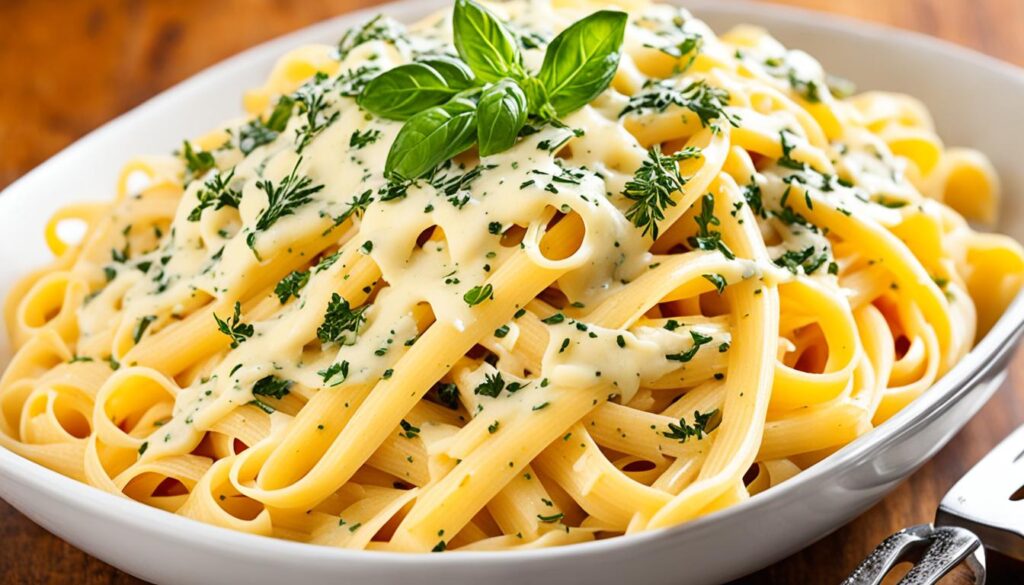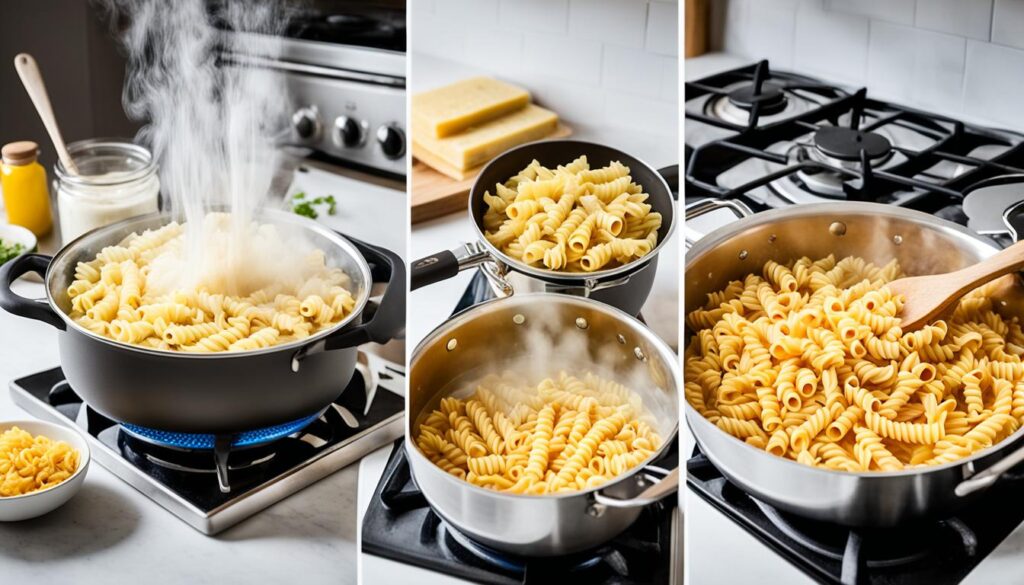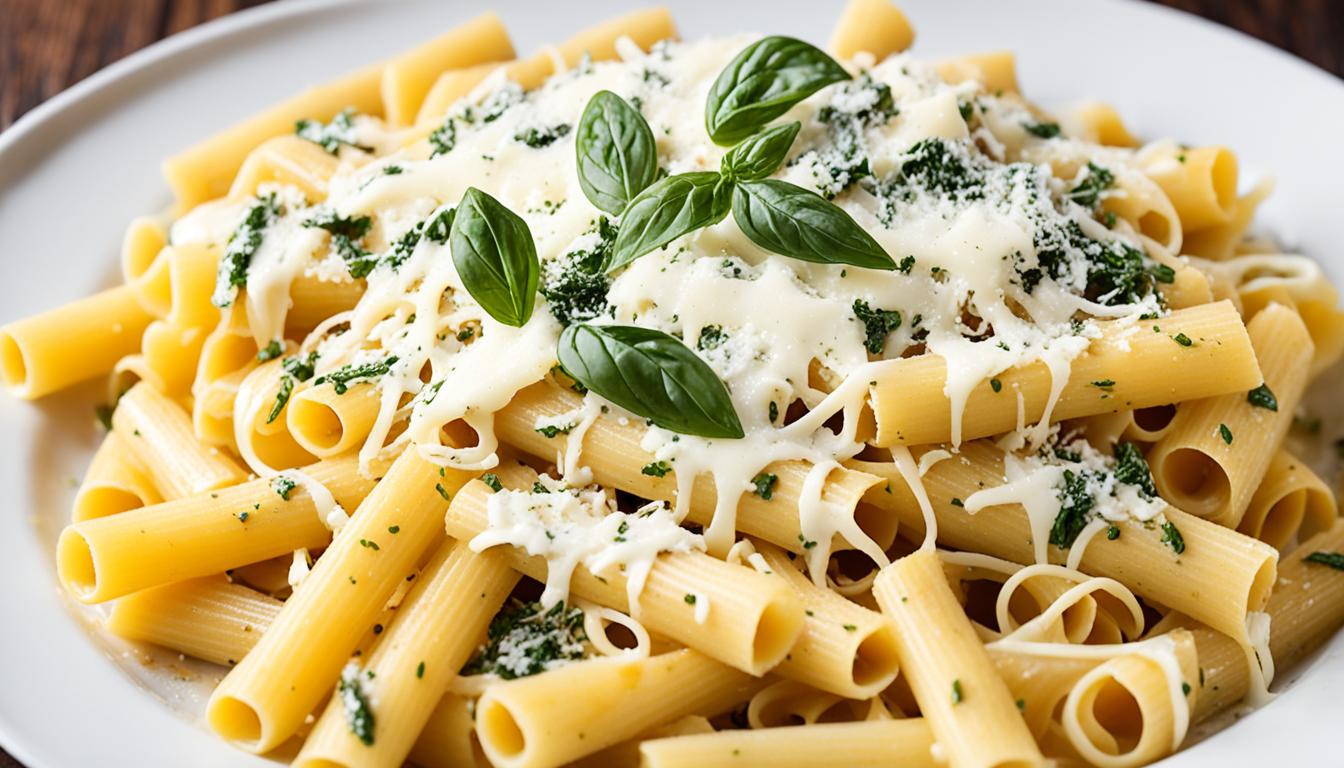If you’re a fan of creamy cheese pasta, get ready to tantalize your taste buds with the perfect pasta ai quattro formaggi recipe. This traditional Italian dish combines the rich flavors of four cheeses to create a truly indulgent meal that’s sure to impress. But have you ever wondered which four cheeses make this dish truly exceptional? Let’s delve into the world of pasta ai quattro formaggi and uncover the secrets behind its irresistible allure.
When it comes to mastering the art of pasta ai quattro formaggi, the combination of cheeses is crucial. But with so many cheese options out there, which ones will perfectly complement each other? And how do you ensure that the sauce turns into a velvety masterpiece that coats every strand of pasta?
In this article, we’ll guide you through the process of choosing the right cheeses, making the creamy sauce, cooking the pasta to perfection, and achieving that mouthwatering final touch. You’ll learn the best cheese combinations, the secrets to creating a smooth and luscious sauce, and the techniques for achieving the ideal texture in every bite.
Get ready to become a pasta ai quattro formaggi connoisseur as we uncover the steps for making this authentic Italian pasta dish. Your taste buds are in for a treat!
Key Takeaways:
- Discover the perfect combination of four cheeses that make pasta ai quattro formaggi truly exceptional.
- Learn the secrets to creating a creamy and velvety sauce that coats every strand of pasta.
- Master the art of cooking pasta to the perfect al dente texture for the ultimate dining experience.
- Uncover the final touch that adds a burst of flavor and texture to this indulgent dish.
- Prepare to impress your family and friends with a homemade pasta dish that captures the essence of traditional Italian cuisine.
Choosing the Cheeses
When it comes to making pasta ai quattro formaggi, the choice of cheeses is key. Different cheeses bring unique flavors and textures to the dish, creating a harmonious blend that tantalizes the taste buds. While there is no strict rule for which four cheeses to use, there are some popular choices that are sure to impress.
Taleggio
Taleggio is a creamy and melty Italian cheese that forms the base of the sauce in pasta ai quattro formaggi. It adds a luscious and silky texture, creating a smooth and sumptuous experience with each bite.
Gruyère or Fontina
Gruyère or Fontina are excellent choices if you want to add nuttier and sweeter notes to the sauce. These cheeses melt beautifully and infuse the dish with their rich flavors, enhancing the overall taste.
Parmigiano-Reggiano or Pecorino Romano
Parmigiano-Reggiano and Pecorino Romano are often used for their fine grating qualities. Grate either of these cheeses over the pasta ai quattro formaggi just before serving to add a delightful burst of savory and salty flavors.
Gorgonzola Dolce
Gorgonzola dolce is a creamy blue cheese that brings a tangy and slightly sweet taste to the dish. Adding gorgonzola dolce to the sauce gives it a unique twist, balancing out the richness of the other cheeses.
Of course, these are just some of the many cheeses you can experiment with for pasta ai quattro formaggi. Feel free to explore different combinations and discover your own favorite blend of flavors. The key is to choose cheeses that complement each other and create a harmonious symphony of taste in every mouthful.
| Cheese | Flavor Profile | Texture |
|---|---|---|
| Taleggio | Creamy, mild | Melty, soft |
| Gruyère | Nutty, sweet | Melty, smooth |
| Fontina | Nutty, sweet | Melty, creamy |
| Parmigiano-Reggiano | Savory, salty | Firm, granular |
| Pecorino Romano | Savory, salty | Firm, granular |
| Gorgonzola Dolce | Tangy, creamy | Soft, crumbly |
Making the Creamy Cheese Sauce
The creamy cheese sauce is the heart of the pasta ai quattro formaggi dish. To create this luscious sauce, we begin by infusing the cream with garlic and thyme. This step adds depth and enhances the flavor profile of the dish.
Next, we carefully melt the cheeses over gentle heat to ensure a smooth and velvety texture. This process requires a delicate touch to prevent the sauce from breaking or becoming too thick. As the cheeses melt, their flavors blend harmoniously, creating a rich and creamy sauce that coats the pasta perfectly.
After the cheeses are fully melted, we whisk them together with the infused cream. This step ensures that the flavors are evenly distributed throughout the sauce, resulting in a consistent taste with each bite. The whisking process incorporates air into the sauce, giving it a light and fluffy texture.

As the creamy cheese sauce comes together, the aromas of garlic and thyme infuse the air, tantalizing our senses. The sight of the cheese melting and blending with the cream is a delight to behold, creating anticipation for the indulgent pasta dish that awaits.
In the next section, we will explore the art of cooking the perfect pasta to complement this heavenly sauce.
Cooking the Pasta
Now that we have our creamy cheese sauce ready, it’s time to cook the pasta. This step is just as crucial as preparing the sauce to ensure the perfect texture and taste in our pasta ai quattro formaggi.
The key to cooking pasta for this dish is to achieve the perfect al dente texture. Al dente means the pasta should be cooked until it is firm to the bite, with a slight resistance in the center. Overcooking the pasta can result in a mushy texture when combined with the sauce, so be sure to keep an eye on the cooking time.
When it comes to choosing the type of pasta for our pasta ai quattro formaggi, there are various options to consider. Here are some popular choices:
- Fusilli: A spiral-shaped pasta that captures the sauce well
- Penne: Short, cylindrical pasta with angled ends, great for holding the cheese sauce
- Angel Hair: Thin, delicate pasta strands that cook quickly and are light in texture
Choose the type of pasta that you prefer and follow the package instructions to cook it to perfection. Now, let’s move on to combining the cooked pasta with our creamy cheese sauce.

Combining Pasta and Sauce
Once the pasta is cooked, it’s time to bring together the flavorful pasta and the creamy cheese sauce. There are two methods you can use to combine them:
“Method 1: Transferring the cooked pasta directly into the cheese sauce”
To seamlessly integrate the pasta and sauce, carefully transfer the cooked pasta directly into the cheese sauce. This method ensures that every strand of pasta is coated with the rich flavors of the sauce. You can use tongs or a pasta server to gently mix the pasta and sauce together, ensuring an even distribution of the cheese sauce.
“Method 2: Using a spider skimmer to transfer the pasta”
If you prefer a more controlled and precise approach, you can use a spider skimmer. This specialized kitchen tool allows you to lift the cooked pasta out of the boiling water and transfer it directly into the cheese sauce while leaving any excess liquid behind. This method is particularly useful if you want to control the amount of pasta water that mixes with the sauce.
Regardless of the method you choose, don’t forget to reserve some pasta water before draining the pasta. Pasta water can be a secret weapon when it comes to achieving the perfect consistency in your sauce. The starchy pasta water can be added to the cheese sauce in small increments to maintain the right balance and prevent the sauce from becoming too thick.
When combining the pasta and sauce, it’s essential to gently stir the pasta in the sauce until it is evenly coated and has a creamy glaze. This careful mixing process ensures that every bite of pasta is infused with the delicious cheese flavors. If you find that the sauce has become too thick during the mixing process, add a little more pasta water to thin it out.
Here’s an overview of the steps:
- Cook the pasta until al dente.
- Choose one of the two methods to combine the pasta and sauce – either transferring the cooked pasta directly into the cheese sauce or using a spider skimmer.
- Reserve some pasta water before draining.
- Combine the pasta and sauce by gently stirring until the pasta is evenly coated with the creamy cheese sauce.
- If needed, add small increments of pasta water to maintain the desired consistency of the sauce.
| Pasta Combining Steps | Pasta ai Quattro Formaggi |
|---|---|
| Step 1 | Cook pasta until al dente |
| Step 2 | Choose method: Direct transfer OR Spider skimmer |
| Step 3 | Reserve pasta water |
| Step 4 | Gently stir pasta in sauce until coated |
| Step 5 | Add pasta water to adjust consistency |
Combining the perfectly cooked pasta and the creamy cheese sauce is a critical step in creating a harmonious and flavorful dish. By following these steps and techniques, you’ll ensure that each bite of pasta ai quattro formaggi is a delectable experience.
Adding the Final Cheese
The final touch to the pasta ai quattro formaggi is adding gorgonzola. This cheese is added last, just before serving, so that it doesn’t fully melt and little bits of it cling to the finished pasta. The gorgonzola adds a burst of flavor and texture to the dish. However, if gorgonzola is not to your taste, you can try other types of cheese that complement the other cheeses in the sauce. The dish is then ready to be served and enjoyed.
Adding the gorgonzola is the finishing touch that elevates the flavors of the pasta ai quattro formaggi. This cheese is known for its pungent and tangy taste, which pairs perfectly with the creamy sauce and other cheeses. As the gorgonzola is added at the end, it retains its distinct character and doesn’t fully melt, creating delightful pockets of intense flavor throughout the dish.
To add the gorgonzola, simply crumble it into the pasta and sauce mixture, gently stirring it to distribute evenly. As it melds with the other cheeses, the gorgonzola enhances the overall complexity of the flavors, contributing its unique creaminess and tanginess. The result is a harmonious blend of cheeses that tantalizes the taste buds.
If gorgonzola doesn’t suit your palate, don’t worry! There are plenty of alternative cheeses you can experiment with to achieve the desired balance of flavors. Try blue cheeses like Roquefort or Stilton for a similar boldness, or opt for milder options like feta or goat cheese to add a subtle twist to the dish.
With the gorgonzola or your preferred cheese added, the pasta ai quattro formaggi is now complete. The final touch brings together all the elements of this indulgent dish, creating a symphony of cheesy goodness. Now it’s time to serve and savor this mouthwatering creation.
Serving and Enjoying
Once you’ve added the final touch of gorgonzola to your pasta ai quattro formaggi, it’s time to serve and enjoy this delectable dish. To fully savor its flavors, it is recommended to serve the pasta immediately after adding the cheese.
You have the option to present the pasta in individual bowls or in a large serving dish, depending on your preference. Whichever way you choose, be sure to garnish your pasta ai quattro formaggi with a generous sprinkling of grated Parmigiano-Reggiano. This adds an extra layer of savory goodness and enhances the overall taste profile.
Now it’s time to dig in and relish the creamy cheese sauce and the distinct flavors of the four cheeses. Gather your loved ones around the table and indulge in this truly indulgent Italian classic. The combination of the rich and creamy sauce with the perfectly cooked pasta is a taste sensation that will leave you craving for more.
Enjoyment awaits you with every bite of this pasta ai quattro formaggi. The blend of cheeses creates a symphony of flavors that will tantalize your taste buds and leave you wanting another forkful. Pair it with a glass of your favorite wine and let the flavors transport you to the heart of Italy.
Conclusion
In conclusion, pasta ai quattro formaggi is a truly indulgent Italian pasta dish that brings together the exquisite flavors of four different cheeses. This rich and creamy sauce, made by infusing cream with garlic and thyme and then melting the cheeses, creates a harmonious blend that coats the cooked pasta in pure deliciousness. The choice of cheeses is a personal preference, allowing you to tailor the dish to your own taste.
When serving pasta ai quattro formaggi, it is important to do so immediately to fully enjoy the flavors and textures. A sprinkling of grated Parmigiano-Reggiano on top adds an extra layer of decadence. This delightful homemade pasta dish is sure to impress your family and friends, making any meal feel like a special occasion.
Indulge in the complex and comforting flavors of pasta ai quattro formaggi, and savor every mouthful of this sumptuous dish. Whether you’re an avid pasta lover or simply looking to elevate your culinary skills, this classic Italian recipe is a guaranteed showstopper that will leave you and your loved ones craving for more.
